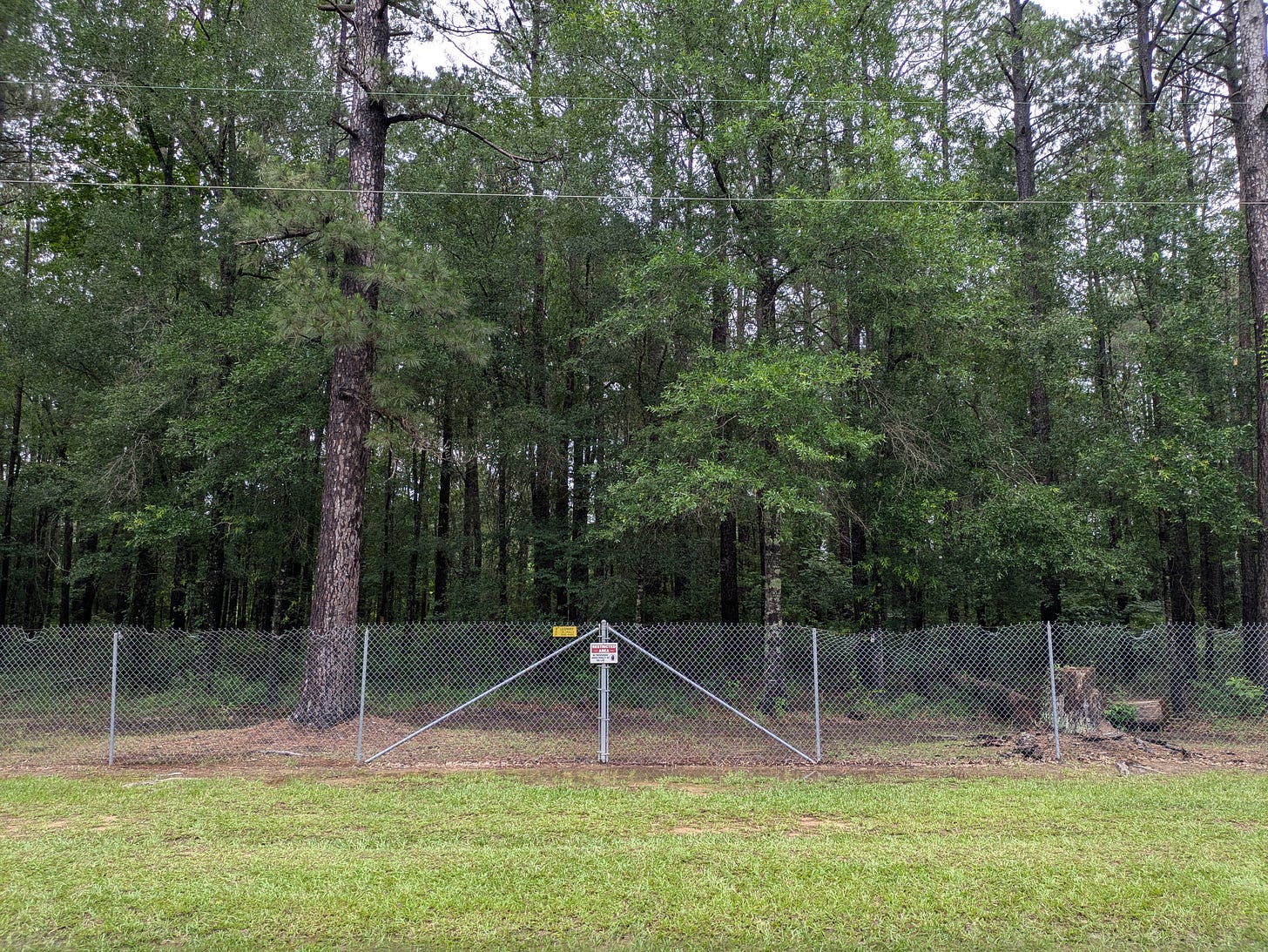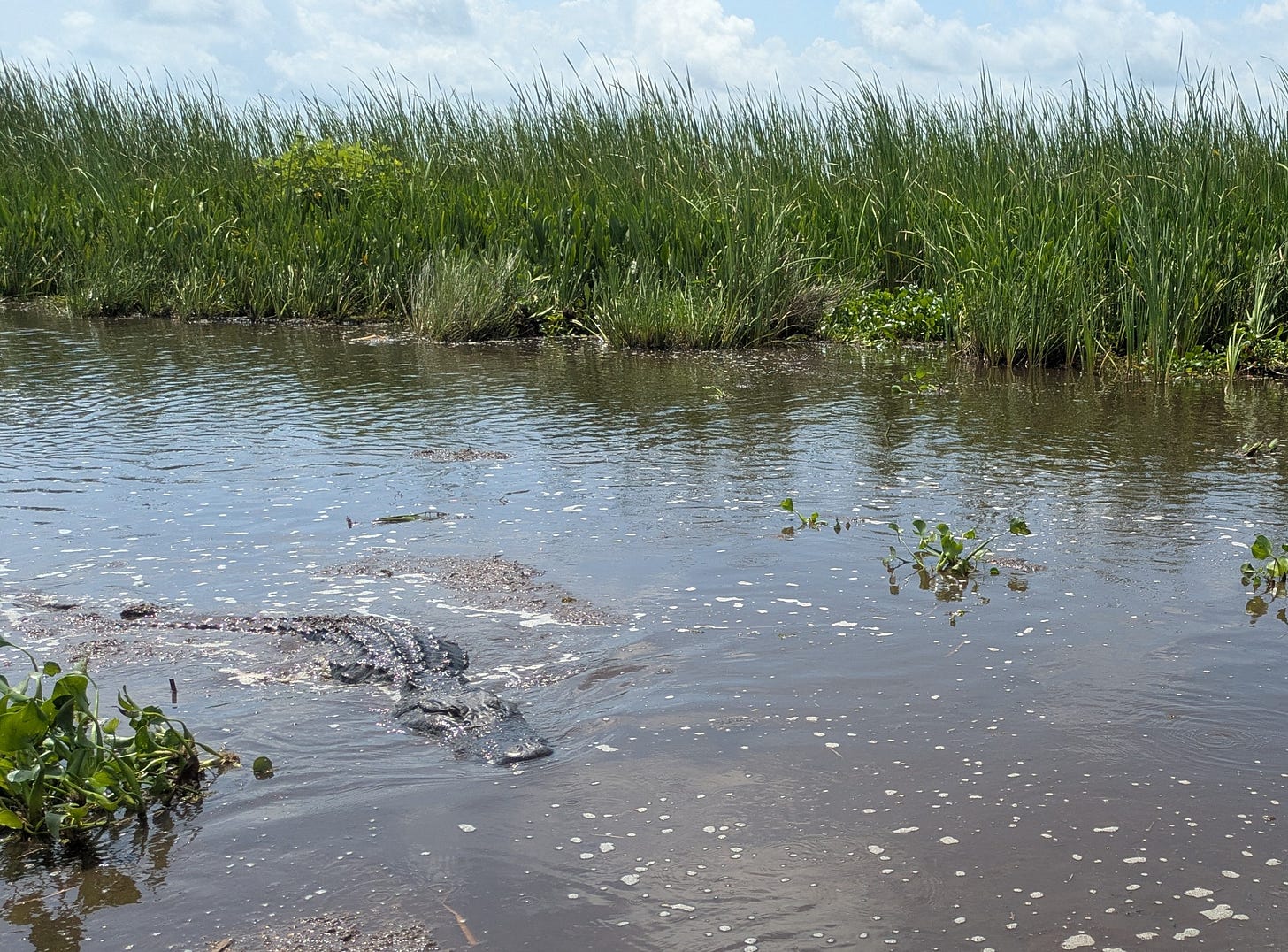Over the Fence--Part 2
Tracking the border between rural America and the US military's explosive waste.
Dearest readers, following up on my last post about the mushroom cloud at Camp Minden, I am sharing an edited fieldnote from my research trip to Colfax, Louisiana. This research is part of a larger project on the challenges of disposing of explosive waste in the United States, a topic that has fascinated and alarmed me for more than a decade. And in other news, I share a few thoughts on recent changes to federal human rights reporting—and the political power of how we define “human.”
Fieldnote from May 26th, 2025:
The power goes out when we cross the border into Grant Parish, Louisiana. I don’t know it, but I notice the eerie silence and the dull windows, a glistening and dark dampness like a wet veil thrown over the land. A storm passed in the night.
After Camp Minden, we drive to Colfax, the parish seat. Colfax began in the 1830s as a plantation on the bank of the Red River, to take advantage of the river’s nutrient rich floods. Today, the town is a little over a mile square with a population of less than 2,000, many of whom are descendants of the original Black families who were forced to settle here.
In 1869, as an act of defiance against this heritage, a descendant of the original plantation owner named the parish for President Ulysses S. Grant and the town for his running mate, Schuyler Colfax, to honor the North’s victory in the Civil War. The town still carries this aspirational mark of defiance and freedom.
The Clean Harbors disposal center is on the outskirts of town. There are no signs for it, but it’s easy to find. Like Minden, I first notice the fence. It’s almost the same fence: a few feet of lawn, the stretched wire, then the lush forest on the other side. I roll down the car window: Verdant green, wet and plump with rain, the smell of soft wood. Pine needles blacken the ground between the trees.
That’s all I can see. I’m looking for hazard signs, but I don’t see them.
We come to a gate. There, at last, is a tiny sign: a black and white placard that says “Clean Harbors” with a phone number. What the sign doesn’t say is that Clean Harbors is the last commercial open burn and open detonation facility in the United States, the only non-military facility exempt from EPA emissions limits for burning hazardous waste.
After the cache of bombs at Minden exploded in 2012, the remaining explosive waste was sent here, to burn in Colfax. The facility had been operating under the radar since the eighties, but after Minden, the pace of the burns increased significantly. The waste processed at the facility included military propellants, TNT, RDX, smokeless powder, gunpowder, and fireworks.
Researchers at Louisiana State University’s Superfund Research Project have demonstrated that harmful pollutants traceable to the facility are traveling as far as ten miles. These substances are known to cause cancer and other serious health impacts.
The detonations themselves shake people’s houses, crack foundations, break windows, rumble the ground, and tar the sky with noxious smoke. It’s like living in a battlefield.
The community of Colfax has been exposed to noise, rumbles, and pollutants from the facility for over forty years.
Despite being the world’s single largest contributor to climate change, the American military is exempt from most federal and international environmental policies and treaties. They don’t have to publicly report their emissions. The military has the right to pollute. For example, the War on Terror contributed a conservative estimate of 1.2 billion metric tons of greenhouse gases to our global carbon footprint—close to the combined annual emissions of the world’s textile and fashion industry. Yet, remarkably, these figures don’t account for places like Clean Harbors, where the munitions that the military doesn’t want any more are abandoned to negligent contractors. Furthermore, the military also maintains its own specialized disposal centers and open burn pits for explosive waste, with limited public oversight.
The United States military has been producing this kind of waste for more than a century, but we’re only just beginning to understand its social and environmental impacts.
In recent years, the Colfax community has successfully increased public pressure on the toxic facility. In 2023, the state of Louisiana revoked the facility’s burn permit. Clean Harbors is in limbo: They’re technically still open and accepting deliveries of waste, but they can’t legally dispose of it. They can either shut down or upgrade their facility to a safer, more expensive closed burn system. Of course, there’s a third option: The military could stop disposing of unwanted explosives through open burns.
Following the fence, we come across Summerfield Baptist Church. It’s a ranch-style building with a long nave of windows, set amongst forest and bare earth. Partially flooded by the storm, the area around the church is beaded with opal pools that reflect a storm gray sky shot with swirls of blue. To either side, there’s a children’s play structure and an elegant, old cemetery.
The cemetery is just over the fence from the facility. The graves meet the metal barrier. With dry humor, I reflect that cemeteries and waste disposal centers have similar real estate requirements. But one is a place of sacred refuge, a holy place, and the other a place of abandonment.
My eyes return to the fence. The fence between the children’s play structure and Clean Harbors. Between the cemetery and Clean Harbors. Between Colfax and Clean Harbors. It’s a false barrier. The fence keeps nothing in and protects nothing but the facility’s secrets.
Who counts as “human” in “human rights”?
Recently, the Trump administration quietly re-defined what it means to be “human” for human rights reporting. The latest State Department human rights report, released this month, is significantly shorter than in previous years. It radically narrows how we measure our rights, and therefore how we protect ourselves and each other from harm.
The State Department no longer documents indicators for women’s rights, such as gender-based discrimination and domestic violence. Also removed are all indicators for queer or trans rights.
This matters because it means that countries with ongoing discriminatory practices against women or queer people can now obtain a higher human rights rating, which qualifies them for a variety of political benefits.
For example, the erasure of these issues from the State Department reporting process makes it a lot harder for asylum seekers to make successful court claims for protection. In my role as a human rights consultant, I rely on these reports to validate country-specific threats. The changes to the reporting process diminish the credibility of America’s human rights expertise, while making it easier for abusive regimes to continue harming people.
The report is also missing indicators for rights associated with democracy, such as freedom of assembly, the right to a fair trial, and the right to participate in political processes. The report no longer includes assessments of election fairness, political corruption, or the treatment of civil society organizations.
As Laura Thornton notes for The Hill, the report may be distressing, but it does “provide an accurate description—by what it does and does not include—of what the U.S. has become.”
As always, if you made it this far, let me know by clicking the “like” button. Research is a lonely job, and I enjoy getting the positive feedback!






